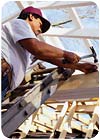
Slips and falls can result in all kinds of serious injuries, including fractures, sprains, head and neck problems, and spinal injuries. These injuries cost employers in more ways than one. A slip or fall injury costs over $20,000 per employee, which includes lost time and workers’ compensation claims. For a small to mid-size company, these costs can really hurt. A combination of engineering controls, hazardous awareness and training is needed to prevent slips and falls from occurring at your work site.
Good housekeeping
By keeping your work site relatively free of debris and other objects, you can greatly reduce the potential for a slip, trip or fall accident. OSHA standard CFR 1926.25, for example, covers good housekeeping on a construction site.
Scraps, in the form of metal, wood with protruding nails, used rags and all other debris should be removed from the work area intermittently throughout the day or when the particular job task is complete. Greater caution should be taken with combustible scraps; these items should be disposed of in a proper, designated waste container. Designated containers must be provided for the separation of waste, trash, oily and used rags, and other refuse.
Keep work areas free of unused tools, power cords and other potential slip and fall hazards. Bottom line — clean up after yourself. When you complete a job, put tools back in their case or designated area. If a spill occurs, clean the spill following the proper procedures for the substance or inform a supervisor. Even a spilled cup of coffee could cause a co-worker to slip.
Wear the proper footwear for your job and ensure you have good treads on the soles of your footwear. This is especially important at work sites such as a construction site where you may encounter various types of surfaces and ground conditions. Also ensure work areas are well lit.
Of course, keep floors well-maintained, and apply non-slip coatings where appropriate.
Ladder use & selection
Ladders can be a dangerous source for slips and falls. You need to understand both the features and the limitations of the ladders you use. Factors to consider when selecting a ladder are the ladder’s duty rating, maximum working height and conductivity.
Most ladder accidents occur from improper or careless use. The ladder should fit the size of your job. For example, a 30-foot extension ladder would not be long enough to climb onto a 30-foot structure. To place the ladder at the proper angle requires additional length. In addition, the ladder must extend three feet beyond the roofline if you want to climb onto the structure.
Your objective when setting up a ladder is to achieve a proper angle in which you can maintain your balance, and to secure the ladder to prevent any potential movement. A ladder should be placed so that its base is one foot away from the vertical support for every four feet of ladder height, commonly referred to as the one-quarter rule. This 75-degree angle utilizes the ladder’s construction strengths and gives you optimum balance when climbing.
If you have to stand on the first step from the top of a stepladder, or the second step from the top of a straight or extension ladder, the ladder is too short for the job and should not be used. On the other hand, a ladder that is too big for the job is also unsafe. If you have to reach forward beyond an arm’s length, get down and get a smaller ladder that will bring you closer to your work.
Check the ladder before each use to ensure there are no cracks, loose rungs or loose hardware.
There are times when the ground beneath the ladder may be uneven. Use a ladder leveler when working on an uneven surface. On soft ground, such as dirt or grass, use spikes to secure the ladder. You should always maintain three points of contact with the ladder. Always use a lift line or tool belt when you need to carry supplies or tools. If your arms are full going up and down a ladder, you are creating an opportunity for a slip and fall accident.
Fall protection is required on fixed ladders above 20 feet. This may be in the form of cages, wells, or other ladder safety devices. When working at any height, fall protection must be considered if both hands are needed to perform the work or the task requires you to work in one place for an extended amount of time.
Identify the hazards
It is important to conduct job hazard analyses at your site. Identify the hazards that exist in your work environment and implement measures to control the hazards through planning for the work environment, using the proper PPE, and implementing devices such as scaffolds, platforms and guard rails, if necessary. Keep all devices in good working order and inspect them regularly for weaknesses or defects.
If exposure to fall hazards cannot be safely eliminated or controlled with the use of such devices, other forms of fall protection can be selected, such as personal fall arrest systems. When used properly, a personal fall arrest system is designed to arrest, or stop, a person in a fall from a working level. There are many possible configurations for a personal fall arrest system. The elements you use will depend on your specific job task and working environment. Make sure you know the capabilities and limitations of the equipment you use and ensure that your equipment is right for the job by examining the potential fall distance, the work being performed and the work environment.